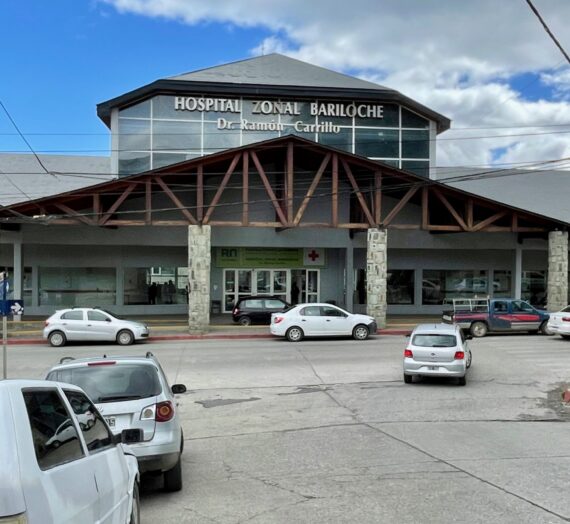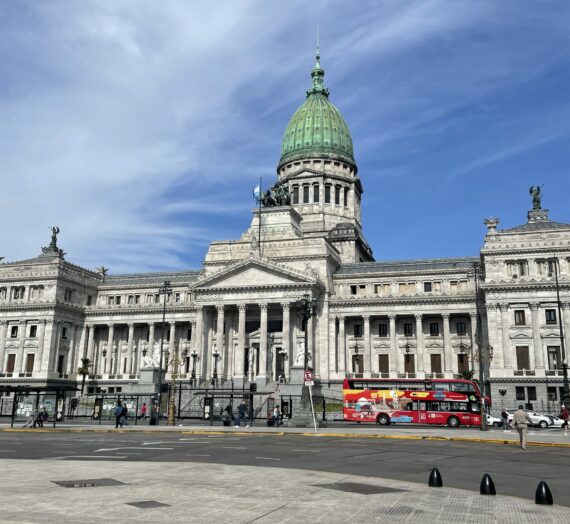The day after our Antarctica Cruise, I was sitting in an Ushuaia restaurant having a drink with one of my shipmates. She confided in me that after leaving Antarctica, she had become quite depressed. Antarctica, after all, was the pinnacle of all she had ever wanted to see and experience. So, what could possibly be out there to look forward to now? It was true, there was a sense that no beautiful glacier or snow-capped peak could ever top what we had just experienced. But next up on my agenda was the infamous cities of El Calafate (Ka-la-fa-te) and El Chaltén. Known as the adventure and hiking capitals of Argentina, I was eager to see what they had to offer.

El Calafate, the larger of the two towns, is located in Central Patagonia. I forfeited the chance to take a 24-hour bus ride from Ushuaia through two border crossings (Argentina to Chile and back to Argentina), and decided instead to buy a 2-hour plane ticket. I’m glad I did. From my seat on the west side of the plane, I was able to say goodbye to Ushuaia and the Beagle Channel backdropped by the wide expanse of mountains on both the Chilean and Argentinian side of Tierra del Fuego (the island at the tip of Patagonia). A little further on, I spotted the conglomerate of mountains that form Torres del Paine National Park in Chile, (which was where I completed my 6-day trek last month: Experiencing the Extremes in Torres del Paine National Park). Finally, laid out before me, was the mountains and glaciers of the Southern Patagonia Ice Field, Los Glaciares National Park in Argentina and the glacial blue waters of Lago Argentino- my destination for the next 10 days.


Los Glaciares National Park is the largest protected area in Argentina covering more than 2,000 square miles. For this reason, it is a UNESCO World Heritage Site. Within its borders is part of the 230-mile long Southern Patagonia Ice Field. This Ice Field flows on the crest of the Southern Andes along the border between Argentina and Chile. It is the largest area covered by ice outside of the Polar and Greenland regions. It is so big, in fact, that it feeds 48 major glaciers that are still grinding down its flanks. El Calafate and El Chalten are famously on the Argentina tourist circuit because both of these towns provide access to Los Glaciares National Park and the chance to see some of these really big glaciers up close.
El Calafate, Argentina
El Calafate is a moderate size community that has turned itself into the adventure capital of Argentina. If you want to hike on the glacier, take 4×4’s above it with a view, go mountain biking or take a cruise to see several glaciers from the lake, this is your place. I chose to go kayaking. I’ve always wanted to kayak up to a glacier, and paddle around the icebergs that have recently calved from its face. So, during a lovely morning in the sun, I did just that. From this angle, Perito Moreno Glacier and Lago Argentino did not disappoint.






It was fun to get dressed in so many layers of neoprene and waterproof jumpsuits with attached boots. If we fell in, the temperature of the water was a refreshing 38 degrees!
After the kayak experience, I then explored the National Park’s viewing platforms to get a higher view of the same glacier. At 98 square miles, it certainly was impressive. And again… the light and the ice was mesmerizing to watch.










Perito Moreno Glacier is 19 miles long, 3 miles wide, and its front face averages around 200 feet of thickness. It is the third largest glacier out of 48 different glaciers fed from the Southern Patagonia Ice Field. At only about 580 feet in elevation, it is one of Argentina’s prized tourist attractions. It is named for a revered Argentinian cartographer who worked to preserve much of Argentina’s wilderness in a system of National Parks. And, you’ll be happy to know, in a world of retreating glaciers, the Perito Moreno Glacier is considered stable or perhaps advancing.


El Calafate’s tour agencies promote an impressive list of other things to do in Calafate, but the prices were also spectacular. I hung around town instead, trying to ignore a pain in my right hip-flexer that had been niggling at me for awhile…frankly, since before the penguins in Punta Arenas. That was a month ago. I was able to successfully ignore it because my toe hurt worse, and my dosing of ibuprofen was taking care of it all. But now that my toe wasn’t hurting any more, I realized that my hip was really giving me fits again. Hummmm… I don’t like getting old.
El Chaltén, Argentina
Onward to El Chaltén – my hiking dream destination! Not every mountain town can boast that they have free hiking trails starting from main street. It is amazing. A waterfall here, a glacier over there, or perhaps a glacier calving into an aqua-blue lake? Whichever you prefer, El Chaltén has it all!








I had been working so hard to keep myself healthy and ready for this dreamy part of my trip, but gosh-darn-it, my hip muscles were not cooperating! I found a physical therapist in town that confirmed what I already knew- I needed to rest, and do some gentle exercises to let the muscles heal. But then, ofcourse, I felt enough relief after her massage that I loaded up on ibuprofen and went on a couple epic hikes anyway!
This hike took me past Glacier Piedras Blancas White and the famous granite spires of Mt. Fitz Roy.
















This hike took me to Laguna or Lake Torre, at the base of the mountain and glacier with the same name.








But, truly, the end for me was near. From El Chaltén, I had planned to hike over the mountains into Chile and continue my travels from there. But exhaustion from the pain got the better of me, and I started to doubt that my adventure plans were very wise. I needed to stop the madness.
So, I pulled out my maps, looked at my options and decided to head back north to Bariloche, Argentina. Located in the lovely Lakes Region, it would be a good place to rent an apartment, rest, and get some medical treatment, too. I only needed to take a bus for 30 hours to get there.
Heading North via Argentina’s Famous Ruta 40
One benefit to changing my plans was that it allowed me to see some of the infamous “Ruta 40” of Argentina. This road, one of the longest and most remote in the world, travels 3,200 miles from the northern Argentinian border with Bolivia to a southern coastal point in the south. The route is famous for the rugged diversity of landscapes it travels through as it parallels the Andes Mountains, crosses numerous National Parks, wide river valleys and the windy steppe, or dry grassy plains, of Central and Southern Argentina. Even though it is a national highway, it is still unpaved in many sections. It would be too costly to manage road building equipment, resources and crews that far out of civilization. It’s that remote.








This southern section of the route is the land of enormous sheep and cattle ranches called “estancias”, wide open semi-arid lands, and relentless wind. Butch Cassidy and the Sundance Kid added some color to the local history as well, as this is the region where they traveled through and lived for awhile.






Hotel La Leona is a popular bathroom and cafeteria stop for the buses along Ruta 40. They like to promote their history with displays of photographs and a signed receipt for when Butch Cassidy and Sundance stayed here.
For 30 hours, I sat on a bus and contemplated this ecoregion called the Patagonia Steppe. In the intense sunlight, it was surprisingly colorful with shrubs and grasses ranging from grey to dark green, lime green and golden yellow. Then we’d come upon a lake, as blue as the sky. The scape seemed endless – sometimes flat, sometimes with gently rolling hills. I didn’t see a building, a driveway or a cross road for hours.




The going was slow, the road was rocky, and the parts that were paved were ridden with potholes. Occasionally we came upon another car on the side of the road changing a tire, or a Dad trying to show a boy which way to stand while peeing with the wind.


Paralleling the road was an equally-endless barbed-wire fence, straight and true. Occasionally, a skeleton of a small guanaco (like a wild llama) was ensnared in its wires.
And the ever present wind… gusts would slam into the side of the bus, a truck with a tow trailer practically riding on one wheel, a motorcycle going down the road leaning to the side.
We made a stop in the dusty town of Gobernador Costa where there was a gas station, a small school with colorful murals on its front, and a few houses noted by the plethora of plastic toys strewn across their sandy yards. Not much else, but an important layover none-the-less for travelers of this endless expanse. On the other side of town, I noticed that a line of telephone poles joined the route. Nothing else for hours.




However, as the bus headed into the more northern regions of Patagonia, I could sense a return to civilization again. Smaller towns were more frequent, rose bushes adorned front porches, and variety of trees started to dot the horizon. The hills turned a deeper green. Obviously, life is just easier out of the windy, barren, plains of Southern Patagonia. It felt nice to be back in the Lakes Region of Argentina again. I do love it here.
Bariloche, Argentina
In the city of Bariloche (Bar-e-lo-chay), I rented an Airbnb, and for three weeks, I slept, did yoga, and gave myself massages. And when that didn’t produce fast enough results, I found two different physical therapists who performed their magic on my muscles. But most of all I willed my body to heal, and used the time to think about what’s next… for the next few weeks, and the months ahead.
You’ll have to wait to see what I’ve planned!



